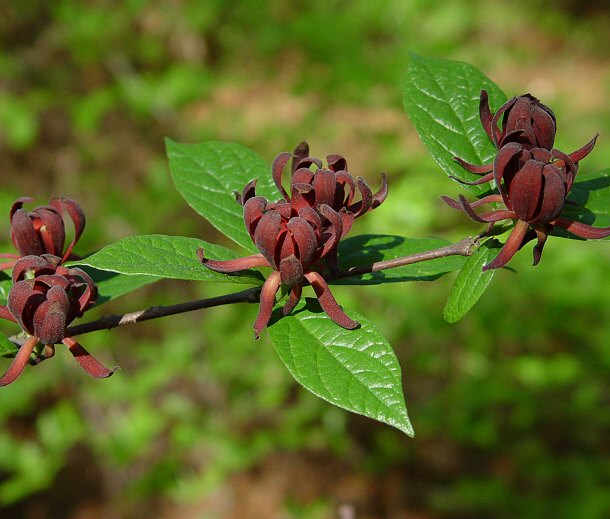Calycanthus floridus L.
Carolina Allspice

Introduced
CC = *
CW = 3
MOC = 3
© DETenaglia
Calycanthus floridus L.Carolina Allspice | |
 |
Introduced CC = * CW = 3 MOC = 3 |
© DETenaglia |
|
Family - Calycanthaceae Habit - Shrub to 3 m. Stems - Erect to ascending, to 3 m, hairy, purplish-brown, buds naked, usually hidden by petioles during growing season.
Leaves - Opposite, simple, short petiolate, ovate to oblong-elliptic, entire, adaxially roughened, abaxially pubescent.
Inflorescence - Flowers solitary at branch tips.
Flowers - Actinomorphic, perfect, perigynous. Perianth of numerous free tepals to 4.0 cm long, hairy on the outer surface, red to maroon, the innermost tepals usually white-tipped. Stamens numerous, the outer 10-15 fertile and the inner 10-25 reduced to linear, hairy staminodes. Pistils 10-35 per flower, each with 1 carpel. Ovary with 1 locule and 2 ovules (1 abortive), hairy. Style slender, attached off-center at the tip of the ovary, with a minute, decurrent stigma.
Fruits - Plump achenes 10-12 mm long, finely hairy, dark brown, with a circumferential seam. Enclosed within the expanded, flask-shaped receptacle.
Flowering - April - June. Habitat - Understory or margin of mesic woodlands. Origin - Native to southeastern U.S. Lookalikes - None when flowering. Other info. - This interesting shrub is rare in Missouri, with only two populations reported in the wild. Both of these represent escapes or plants persisting from former cultivation. The population in Babler State Park (St. Louis County) was discovered in 1995 by members of the Webster Groves Nature Study Society. Outside of Missouri, the plant's range is the southeastern U.S. Photographs taken in Linville, NC, 5-11-03, and in Auburn, AL, 4-16-05 (DETenaglia); also at Babler State Park, St. Louis County, MO, 11-14-2011 and 5-2-2017 (SRTurner). |